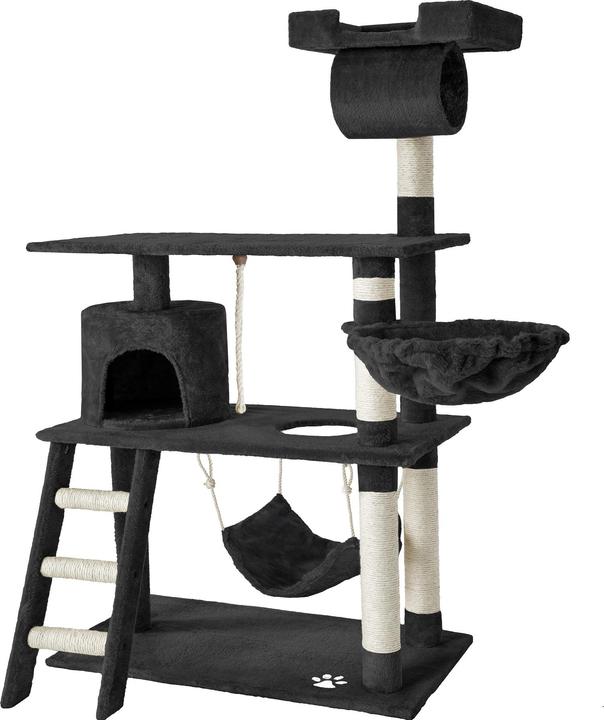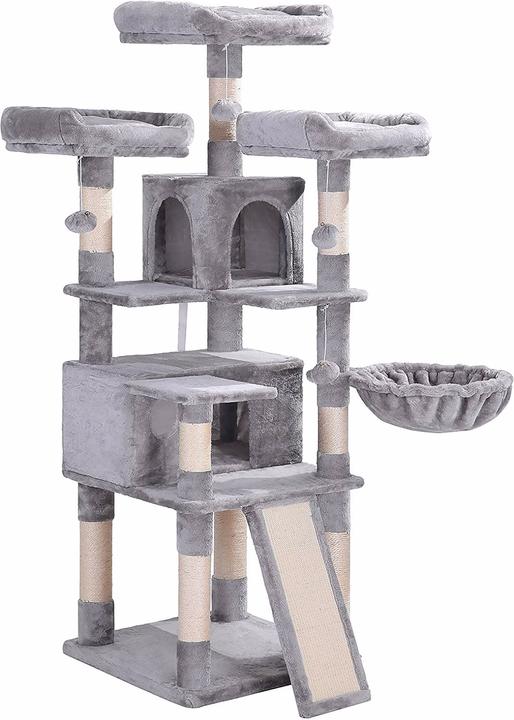

Housecat needs 101
Housecats need a lot more than you’d think to feel comfortable indoors – well-ventilated places, a touch of clutter, and open litter boxes. And a buddy.
Welcome to beautiful Switzerland, a land infamous for its organisation and cleanliness. Such are most apartments and houses in this country, too. Many of them are shared with pets – among them, about 1.85 million cats. The hitch? Cats love (cultivated) chaos. Yet many aren’t allowed out into the wide world to experience new things. They’re living in a kind of eternal lockdown.
That doesn’t sound great. Indoor cats do indeed have a much harder time fulfilling their many needs than they would outdoors. But you can still give them a good and exciting life by creating an appropriate environment. What exactly does that entail? I turned to Swiss cat psychologist Claudia Kasper for answers.
Her urgent appeal right at the start: «A housecat shouldn’t be treated like an undemanding house plant – on the contrary. Creating appropriate living conditions is no easy feat, but worth investing in; the alternative includes boredom, depression, obesity and behavioural problems.»
Before we look at the dos and don’ts, Kasper also points out the legal situation as well as personal responsibility. «Outdoor cats can seek out buddies in their neighbourhood, a privilege denied to housecats. For this reason, cats, which very social animals, should never be kept alone in an apartment, but with a suitable cat partner – aside from the true lone wolves. The Animal Welfare Act states that cats kept alone should have daily contact with people or visual contact with other cats, but that’s not enough.»
Cats need company and shouldn’t spend the whole day alone at home. What they want is a species-appropriate counterbalance to their human. Namely, a feline friend. Now, onto the rest of the tips:
Multidimensional – or what a cat-friendly apartment looks like
Keeping your cats in a small, one-room apartment isn’t a good idea. But you don’t need an XXL penthouse either. In a nutshell, the lower limit is a two-room apartment with a kitchen and bathroom without any no-go zones. This offers your housecats enough room to withdraw once in a while. Even more important is to pay attention to the third dimension: to see without being seen. Cats rarely hang out on the floor. Instead, they prefer to observe their surroundings from a safe vantage point, for example, from an elevated spot on a cabinet or shelf. In other words, your cat needs plenty of options for lying down or sleeping at a height.
Equally important are good hiding and napping spots. Some cats like open sleeping spaces, while others prefer to curl up in a laundry basket, the closet, their cat carrier or a drawer. Others still may opt to squeeze into a bookcase somewhere between the books, or to lie down in the dust under the sofa. If your cat prefers a cosy surface to lie on, you can use old terry towels, rag rugs, wool blankets or patchwork quilts.
Good hiding places can also be created in no time at all by wrapping some fabric around the legs of an armchair or setting aside a cardboard box with a side entrance that’s closed at the top. Absolute privacy is one of the basic needs a cat has. Oh, and wrapping paper can also prove a source of great joy – at least until your cat loses interest.
Kasper’s point: «Sterile, minimalistic interior design completely contradicts the cat’s nature. That’s why it’s a token of love to not always meticulously put everything away immediately and to provide for variety. Apartment cats spend their entire lives in the same space, which is why it’s so important to make sure their needs are met within our own lifestyle.»
Finally, an adventure! Scratching options and games for cats
The ideal [cat tree](/search?q=cat tree) should go all the way up to the ceiling and be stable, ideally made of a durable wood or sisal. Another important feature to have is a column that’s 80 to 100 cm in height – uninterrupted by any elements, so that your cat can sharpen its claws in an outstretched position. Your cat tree should have several levels and hammocks for chilling, as well as a cosy cave for hiding and resting. In addition, toys such as balls and feathers can keep your kitty active and entertained. Finally, find the right place for your cat tree. Where it shouldn’t go is in some separate room, far away from humans. Near windows, on the other hand, is a great location.
But at the end of the day, nothing’s more important than regular interaction with humans. So, have some solid playtime with your feline every day. This strengthens your bond, and you get to know each other better. Cats often also appreciate the simple things in life more than expensive designer duds. Don’t throw away paper bags and boxes right away. And a well-placed scarf over an armchair can serve as an exciting hiding place that costs nothing.
Something that’s always a good idea is an activity board that makes your cat work for their treats. You can quite easily make one yourself from cardboard and toilet paper rolls. And since eating is unfortunately often a go-to for bored housecats, it’s a good idea to serve their dry food in little containers with holes, so that eating is more akin to hunting for a mouse.
Sniffing is a must
Have you ever wondered why your furbabies love to lie in still untidy suitcases or right on top of your handbag or clothes? No, it’s not because they’re trying to annoy you, but because it smells so interesting and new. Cats have an excellent sense of smell that helps them explore their surroundings and find their prey. A cat's nose contains about 200 million olfactory cells, compared to about 5 million in humans. They also use their Jacobson’s organ, which essentially allows them to smell with their mouths, to help them better perceive scent molecules. In addition, the part of their brain responsible for the sense of smell is relatively large compared to other mammals.
All this contributes to the fact that cats have a very sensitive and precise sense of smell, which allows them to detect even faint odours. To keep your housecat happy, you’ll need to give them something to smell. «Regularly bring them new scents from outside: a branch with leaves, pine cones, fresh grass or even hay from the meadow, which you can turn into an absolute highlight by placing it in a cardboard box,» says Claudia Kasper.
A room with sunlight and a view
Cats love to look out the window; they’re curious animals and like to observe their surroundings. Offering them cosy places with a view is part and parcel of having a housecat. «Unfortunately, many modern apartments no longer have a window sill. What you can do then is move a dresser to the window or put an ironing board in front of it,» advises Kasper.
Be sure to also provide sufficient fresh air. Opening windows will allow your cat to breathe in the fresh air, and they’ll feel better. Just make sure they can’t jump out the window or injure themselves. For example, a window that’s tilted open is dangerous, as cats can get trapped in it. That’s why you’ll want to invest in cat protection. For the balcony, it’s recommended to turn to a professional. Window protection, on the other hand, including a fancy perch, you can easily mount yourself. Just be sure to obtain permission from your landlord.
Litter box – topless is the way to go
A good litter box is clean and fragrance-free, located in a low-traffic area, and provides enough space for your cat. You should have one litter box per cat, so, two cats will need two litter boxes. This also suits cats’ natural behaviour, which is to defecate in one place and urinate in another.
Closed toilets are not cat-friendly. By nature, cats clean themselves in well-ventilated, open places outdoors – never in a cavern. The size of the litter box is also important. It should be big enough for your cat to comfortably sit in it, turn and scratch around. If something’s off, you’ll find your cat doing its business outside the box. A good way to improve hygiene is to use special litter mats that collect litter and are easy to clean. Oh, and stay away from perfumed litter; instead, clean out the box more often.
Header image: ShutterstockHealth, sexuality, sports and sustainability. Delve into all aspects of this life less ordinary with the right amount of curiosity, humour and a pinch of salt.




